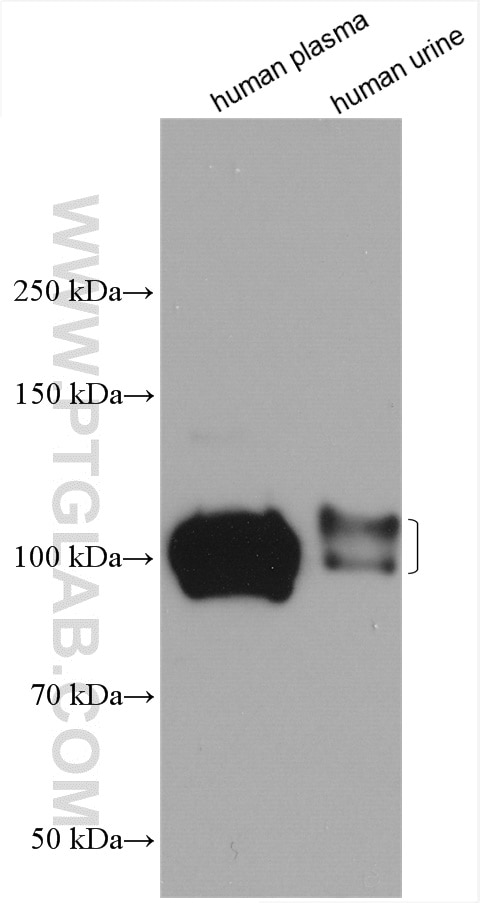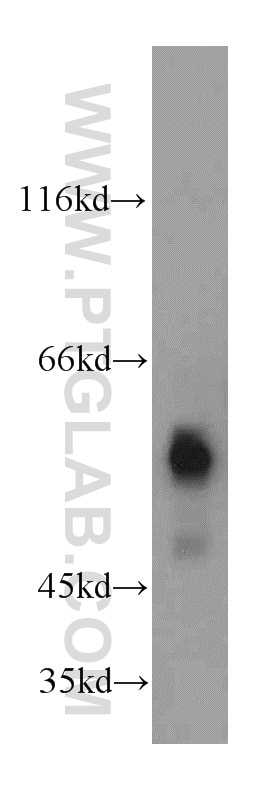SERPING1/C1 Inactivator Polyklonaler Antikörper
SERPING1/C1 Inactivator Polyklonal Antikörper für WB, IHC, IF/ICC, ELISA
Wirt / Isotyp
Kaninchen / IgG
Getestete Reaktivität
human, Maus
Anwendung
WB, IHC, IF/ICC, ELISA
Konjugation
Unkonjugiert
Kat-Nr. : 12259-1-AP
Synonyme
Galerie der Validierungsdaten
Geprüfte Anwendungen
| Erfolgreiche Detektion in WB | human plasma, HeLa-Zellen, HepG2-Zellen, humanes Lebergewebe, humanes Uringewebe, L02-Zellen, Mauslebergewebe |
| Erfolgreiche Detektion in IHC | humanes Tonsillitisgewebe Hinweis: Antigendemaskierung mit TE-Puffer pH 9,0 empfohlen. (*) Wahlweise kann die Antigendemaskierung auch mit Citratpuffer pH 6,0 erfolgen. |
| Erfolgreiche Detektion in IF/ICC | HepG2-Zellen |
Empfohlene Verdünnung
| Anwendung | Verdünnung |
|---|---|
| Western Blot (WB) | WB : 1:1000-1:4000 |
| Immunhistochemie (IHC) | IHC : 1:50-1:500 |
| Immunfluoreszenz (IF)/ICC | IF/ICC : 1:200-1:800 |
| It is recommended that this reagent should be titrated in each testing system to obtain optimal results. | |
| Sample-dependent, check data in validation data gallery | |
Veröffentlichte Anwendungen
| WB | See 5 publications below |
| IHC | See 3 publications below |
| IF | See 3 publications below |
Produktinformation
12259-1-AP bindet in WB, IHC, IF/ICC, ELISA SERPING1/C1 Inactivator und zeigt Reaktivität mit human, Maus
| Getestete Reaktivität | human, Maus |
| In Publikationen genannte Reaktivität | human, Maus |
| Wirt / Isotyp | Kaninchen / IgG |
| Klonalität | Polyklonal |
| Typ | Antikörper |
| Immunogen | SERPING1/C1 Inactivator fusion protein Ag2819 |
| Vollständiger Name | serpin peptidase inhibitor, clade G (C1 inhibitor), member 1 |
| Berechnetes Molekulargewicht | 500 aa, 55 kDa |
| Beobachtetes Molekulargewicht | 100 kDa |
| GenBank-Zugangsnummer | BC011171 |
| Gene symbol | SERPING1 |
| Gene ID (NCBI) | 710 |
| Konjugation | Unkonjugiert |
| Form | Liquid |
| Reinigungsmethode | Antigen-Affinitätsreinigung |
| Lagerungspuffer | PBS mit 0.02% Natriumazid und 50% Glycerin pH 7.3. |
| Lagerungsbedingungen | Bei -20°C lagern. Nach dem Versand ein Jahr lang stabil Aliquotieren ist bei -20oC Lagerung nicht notwendig. 20ul Größen enthalten 0,1% BSA. |
Hintergrundinformationen
SERPING1, also known as C1 Inhibitor (C1INH), is a member of the Serine proteinase inhibitor family. Its main function is the inhibition of the complement system to prevent spontaneous activation. It inhibits activated C1r and C1s of the first complement component and thus regulates complement activation. Deficiency of this protein is associated with hereditary angioneurotic oedema (HANE). C1INH is the most heavily glycosylated plasma protein. Of its 95-105 kDa apparent molecular mass, the protein moiety of 500 aa accounts for only 55 kDa. The native 105 kDa form of C1INH could be cleaved into 60-65 kDa fragments.
Protokolle
| Produktspezifische Protokolle | |
|---|---|
| WB protocol for SERPING1/C1 Inactivator antibody 12259-1-AP | Protokoll herunterladen |
| IHC protocol for SERPING1/C1 Inactivator antibody 12259-1-AP | Protokoll herunterladen |
| IF protocol for SERPING1/C1 Inactivator antibody 12259-1-AP | Protokoll herunterladen |
| Standard-Protokolle | |
|---|---|
| Klicken Sie hier, um unsere Standardprotokolle anzuzeigen |
Publikationen
| Species | Application | Title |
|---|---|---|
Glia Knockdown of circulating C1 inhibitor induces neurovascular impairment, glial cell activation, neuroinflammation, and behavioral deficits. | ||
J Neuroinflammation Fluoxetine inhibited the activation of A1 reactive astrocyte in a mouse model of major depressive disorder through astrocytic 5-HT2BR/β-arrestin2 pathway. | ||
J Thromb Haemost The Alzheimer's disease peptide Aβ promotes thrombin generation through activation of coagulation factor XII. | ||
J Thromb Haemost The Alzheimer's disease peptide β-amyloid promotes thrombin generation through activation of coagulation factor XII: reply. | ||
J Alzheimers Dis A New Serum Biomarker Set to Detect Mild Cognitive Impairment and Alzheimer's Disease by Peptidome Technology. | ||
Urol Oncol Decreased expression of serine protease inhibitor family G1 (SERPING1) in prostate cancer can help distinguish high-risk prostate cancer and predicts malignant progression. |












